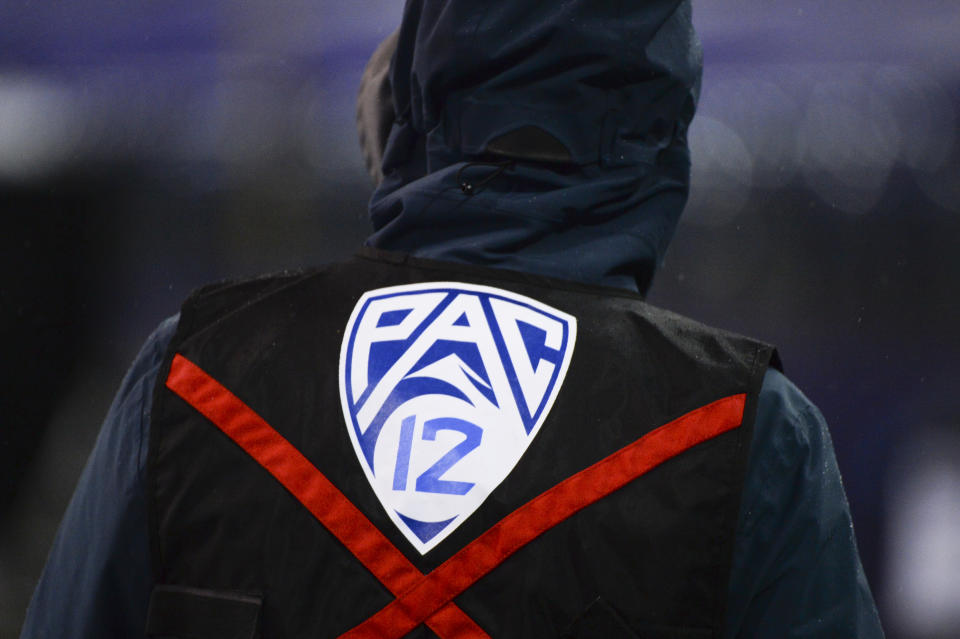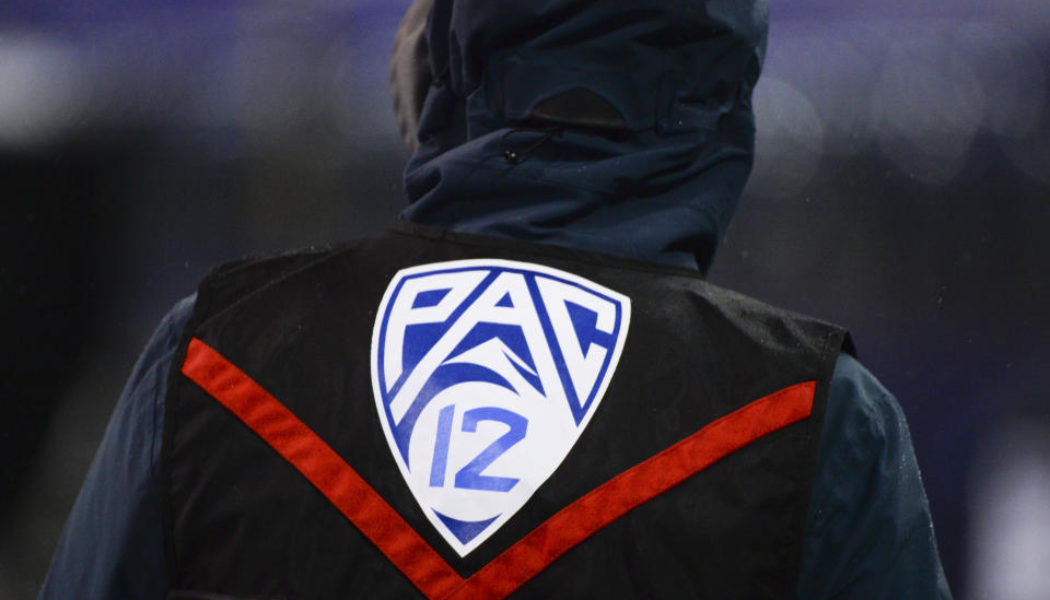Twelve days ago, Pac-12 commissioner George Kliavkoff stepped to the stage at the conference’s annual football media day oozing with confidence about his conference’s impending television deal.
The longer the Pac-12 waits, the better its potential suitors get, he said.
The patience of his presidents will, in the end, pay off, he claimed.
The deal will be good enough to keep intact the 10 school members, he bellowed.
“I saw his comments and I was like, ‘Oh my God,’” one TV executive told Yahoo Sports. “Either he’s the greatest poker player or he’s just bluffing.”
On Tuesday morning, as Pac-12 executives met virtually to, finally at long last, see details of the conference’s potential television deal, no rabbit appeared from a hat.
No ace was pulled from a sleeve.
Kliavkoff presented what so many expected for months now: a streaming carrier (Apple) as a primary rights-holder, with an annual distribution per school that is less than the rival Big 12’s figure ($32 million), sources confirmed to Yahoo Sports.
The presentation actually featured at least two proposals, one less lucrative than the other, depending on the amount of subscription-based incentives met and the addition of outside linear partners, such as ESPN and Fox, who would share in the broadcasting rights of marquee games.
Pac-12 presidents and athletic directors left the hour-long meeting with no agreement. Another meeting is expected to be scheduled soon. Each executive will socialize the plan with their school administrators in an effort to determine next steps.
Having already lost Colorado to the Big 12, the Pac-12’s own survival is at stake. The predominance of the deal’s streaming portion, as well as the fluctuating price tag, pushes the conference into a more precarious position.

Schools with more lucrative television offers — presumed to be Arizona, Arizona State and Utah — have a decision to make: accept an invitation from the Big 12 or remain with the Pac-12. A decision timeline isn’t clear, but the Arizona Board of Regents, which manages both Arizona and Arizona State, discussed the matter in private during an executive session on Tuesday afternoon — a sign of the seriousness of the situation.
One source described the presented TV deal as not suitable enough to keep all three within the league. After a year of TV negotiations — with miscalculations and missteps along the way — could the deal somehow get better over a matter of days?
“If we had a good deal, we’d have presented it earlier,” says one league source.
And so, what now? The decision from Arizona, Arizona State and Utah could have a cataclysmic impact on the college sports landscape, spanning coast to coast and impacting as many as five leagues.
“If anyone follows Colorado,” says one administrative source, “that thing is standing on a knife’s edge.”
How the Pac-12 got here
The crippling blow happened more than a year ago.
USC and UCLA’s announcement of their 2024 departure to the Big Ten sent the conference’s value tumbling by as much as 40%, TV network experts say. Despite the loss of the Los Angeles market, the Pac-12 “shot high” at the beginning of negotiations last summer and fall, says one source. The league’s starting point in per-team distribution neared $50 million — roughly $15 million more than league teams receive in its current TV deal.
Pac-12 officials hoped to be worth roughly 3/4 of the value of the recently signed Big Ten TV contract, a more than $1 billion-a-year deal that is expected to eventually distribute in excess of $70 million annually to members. Ironically, the Big Ten secured such a massive deal on the heels of USC and UCLA joining the conference.
Another blow to the league unfurled later in the fall, when Big 12 commissioner Brett Yormark, an aggressive New York businessman, surprisingly leaped into the market, signing his conference to new long-term TV contract with Fox and ESPN. In many ways, he cut the Pac-12 in line — at the time a bizarre move that now proves shrewd.
“They got out-played by the Big 12,” says another TV executive.
As fall turned into winter, the first of several presumed deadlines — the Pac-12 championship game — passed without a deal. No announcement came at the Pac-12 men’s basketball tournament in March. Nothing in mid-April either, a deadline which was set publicly by one of the conference’s presidents.
And then, in a stunner, the Pac-12 didn’t announce a deal before the key date of June 30, when the conference’s top expansion target, San Diego State, hit a deadline. SDSU’s exit fee due to the Mountain West ($17 million) doubled after that date. The Aztecs owe the league about $34 million if they want to begin play in the Pac-12 next fall.
A media market that had seen the Big Ten and SEC agree to mega deals over the previous three years suddenly began to crumble under the changing landscape — cord-cutting consumers and streaming options. Money in the market evaporated.
ESPN, Fox, NBC and CBS had all recently struck partnerships with other conferences, including the SEC (ESPN), the Big Ten (Fox, NBC and CBS) and the Big 12 (ESPN and Fox).
“The market turned against George,” says one former athletic administrator who remains in the college space. “If you can get 80% of what you ask, you usually take it. You don’t hope for 110%.”
In the end, ESPN and Fox showed interest — and still do — in providing a small window of linear exposure. But monetarily, it is not enough to push the distribution figure higher than the Big 12 — or even that close. For that to happen, it necessitated an entity offering a large guarantee on the front end.
Is Apple’s guarantee enough?
In the most recent sign of desperate times, Pac-12 leaders last month approached NBC for at least the third time in the last year, this time with a significantly low offer.
The network passed.
“We were looking for a savior but no one seemed to want to step up,” says one Pac-12 insider.
Where the Arizona schools stand
On Tuesday afternoon, the Arizona Board of Regents met virtually in a live-streamed session that lasted … about 40 seconds.
The board immediately convened into executive session for a private discussion that was expected to center around this matter. In a setup not wholly unique to higher education but certainly notable, the board manages both Arizona State and Arizona, approving key decisions for both universities.
The 12-member board is made up mostly of civic leaders, former and current business executives and titans of the tech industry with connections to the state and/or schools. Most of the time on athletic matters, such boards rubber-stamp decisions from athletic directors and school presidents.
However, this decision — a conference move — is more significant and impacts both schools. Like many states, politics are involved. Officials in the state believe that high-level decision-makers — including board members and even those in the executive branch of government — wish both schools to participate in the same conference.
This is nothing new. Oklahoma political leaders publicly blasted OU’s decision last year to leave brethren Oklahoma State and the Big 12 behind for the SEC.
Notable in Arizona is the president of Arizona State: Michael Crow, a 67-year-old who has presided over the university since 2002 and one who holds considerable authority in the state and with the board. For years now, Crow has been one of the most vocal supporters of the Pac-12 and one of its loudest chest-beaters about the league’s future.
“He is powerful in that state,” says one person familiar with the Arizona landscape. “When he talks, they listen.”
Arizona and Arizona State both entered the league at the same time: 1978. Can the schools be split?
Arizona president Robert Robbins was asked that question in early June. Arizona has the authority to make a move without ASU, he said. However, he continued, it would be “unlikely” if that were to happen.
While Crow’s influence cannot be understated, the details of the TV contract are important. Media rights deals are the primary revenue-generators for NCAA schools. The millions are used to compete in an ever-evolving recruiting landscape where resources are at a premium. They pay for new facilities, coaching salaries, athlete benefits and supplement Olympic sports programs that cost millions every year.
It’s not only about money. Visibility and exposure is imperative. In fact, in previous interviews, Robbins has expressed disinterest in any TV deal where primary avenue is streaming.
But switching conferences is no easy decision, especially in this situation.
A departure of one or both of the Arizona schools could send the conference into a spiral toward complete collapse.
“Who wants to be the guy to destroy the conference?” asked one seasoned college administrator.
The Ducks and Huskies
The doomsday scenario for the Pac-12 — which appears to be in play — is the departure of Arizona, Arizona State and Utah.
That leaves six teams, a grouping that, from geography, culture and revenue standpoints, are easily categorized into three groups: the big brothers (Oregon and Washington); the little brothers (Oregon State and Washington State); and the other two (Stanford and Cal).
What happens to these schools? A few scenarios seem to exist:
– Option 1: The six schools add known expansion targets San Diego State and SMU, as well as other programs in the Mountain West. There are two problems here. For any Mountain West programs to begin playing football next fall, the exit fee is about $34 million — each. Another problem: Replacing Colorado, Arizona, Arizona State and Utah with these options likely drops the value of the league considerably and, thus, the potential TV deal.
– Option 2: The six schools merge, in some way, with another league to form what might be a new conference. Is the 10-team Mountain West interested in a merger to create a 16-team western league? Would the ACC, long in discussion with the Pac-12 over a partnership, be interested in merging in some way? These are distant and maybe even highly unlikely scenarios.
– Option 3: Each of the three groupings goes its own way. Oregon State and Washington State are sensible additions to the Mountain West. Stanford and Cal, Bay area academic institutions, could become independents, especially the Cardinal. And what about Washington and Oregon?
“If the Pac-12 starts to unravel, maybe the Big Ten figures a way to take Oregon and Washington with as minimal of an impact as possible, financially, to have partners for LA schools,” suggests one source in the college space.
For months now, Big Ten administrators have steadfastly and publicly voiced their stance on further expansion: They are not interested.
But what if this western domino effect changes minds? Both Oregon and Washington were on the Big Ten’s list of potential expansion targets under former commissioner Kevin Warren. In a potentially desperate situation, Oregon and Washington may accept distribution shares at a low rate. Will new commissioner Tony Petitti and his presidents crack the door?
The Big Ten isn’t the only power league with possible interest in the Ducks and Huskies. The ACC, itself in a financial jam of sorts, could add name brands despite the logistical nightmare of cross-country travel.
However, a handful of ACC officials expressed disinterest in such a move. Stuck in a TV contract with ESPN for another 12 years that pays a fraction of SEC and Big Ten money, the league vetted expansion possibilities over the last several months as it worked to uncover additional revenue streams.
No scenario added enough value — the addition of West Coast schools included. A partnership with the Pac-12, long discussed between the leagues, also does not add the value necessary, multiple ACC administrators say.
“It ends up being ‘Hey, what are the dollars?’” says one ACC AD.
“I don’t see the value,” says another.
But, still, in the mad dash to consolidate college football’s biggest brands, would minds change?
“The ACC has been and remains highly engaged in looking at anything that makes us a better and stronger conference,” ACC commissioner Jim Phillips told ESPN last month. “We’ve spent considerable time on expansion to see if there is anything that fits. We have a tremendous group of institutions but if there was something that made us better, we would absolutely be open to it.”
Oh, what could have been
Last July, Big 12 officials fielded a call from Kliavkoff.
USC and UCLA had just announced their impending departures from the Pac-12. In an attempt to preserve his conference, Kliavkoff wanted to know if Big 12 administrators were still interested in a proposal that then-commissioner Bob Bowlsby made to the Pac-12 a year before. After Oklahoma and Texas announced their departure from the Big 12, Bowlsby visited Kliavkoff for an in-person meeting about a partnership or merger of the two leagues.
Kliavkoff turned it down.
A year later, here he was calling to accept it. Big 12 officials, having settled into their new reality and with four new members on the way, declined. “It was a short conversation,” says one Big 12 official with knowledge of the talks.
The Pac-12 now barrels down its most pivotal week and potentially its last of existence. Already, many administrators around the country are presuming its demise, which, they add, is not a positive for college athletics. On multiple occasions over the last year, SEC commissioner Greg Sankey has expressed that the NCAA needs a “strong West” in its goal of being a national association.
Most across college sports agree.
Says one executive in the college space: “If I could turn back the clock, I’d put the LA schools back in the Pac-12. That’s the original sin of George (Kliavkoff), not opening an office in LA and saying to them, ‘What do you need? What do you want?’”
But the Pac-12 troubles go beyond its current commissioner. The league continues to crawl out of hole made by the failures of the Pac-12 Network, the ghastly baby of its last commissioner, Larry Scott. Scott promised administrators lofty figures as part of the league’s plan to start its own independent network, declining to partner with a major distribution carrier.
That said, school presidents are to blame as well, administrators say. After all, commissioners work for a board of presidents that, in this case, should have “demanded a more honest assessment of where they are,” says one official.
There are plenty of missteps along the way. The Pac-12 should have added San Diego State and BYU long ago, says one college sports veteran. Also, waiting so long to strike a TV deal backfired in a market that is teetering, says another. “The dynamic is the opposite of what George said,” the person said. Networks, he continued, are making more selective decisions the longer you wait.
Either way, the Pac-12 is on life support. A decision from the Arizona schools could prove as a lifesaver or a death blow. The latter is likely to fuel another realignment wave.
In early June, at an event in Washington, D.C., Sankey fielded questions about the evolving landscape of college sports. During a question-and-answer segment specifically about conference realignment, Sankey told the crowd before him that his hope was there would be no more realignment this cycle.
“I hope everybody stays where they are,” he said. “I welcome everybody to remain and be happy.”
Seated mere feet from Sankey, in the very front row, was the host of the event himself. None other than Robert Robbins, the president of Arizona.
Services Marketplace – Listings, Bookings & Reviews








